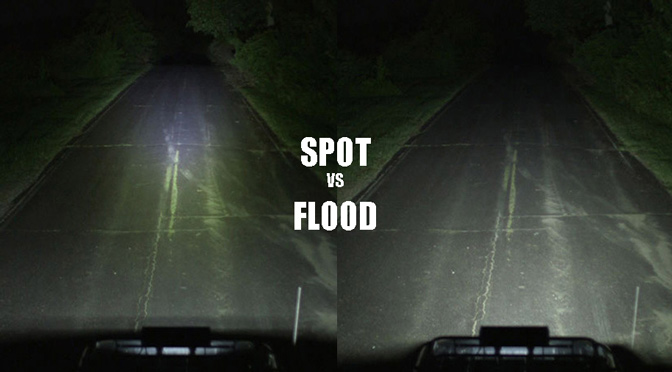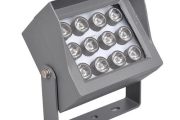What’s the difference between a floodlight and a spotlight? What are the best situations for each? These are the questions you may ask yourself when deciding which light is right for your needs. In this article, we will explain the answers to all your questions.
1. What is flood light and spotlight
Understanding the difference between the floodlight and spotlight is important to properly lighting any application. Before you understand the differences, you must know what a beam pattern is. Beam angle or pattern is a measurement of the angles that are formed between a cone of light’s brightest point (the center) and the points on both sides of the center where the light’s intensity is 50 percent as bright.
In the picture, we can clearly see that a larger beam angle means a wider spread of light across an area, and, likewise, a small beam angle means a narrower spread of light.
Although it depends on the angle and individual lighting retailers, small beams are often referred to as spot beams, while larger angles (usually anything above 90 degrees) are considered flood beams. Light bulbs and fixtures may not always be specifically marked as spots or flood lights, but their beam pattern defines them as spots or flood lights. There are many different styles of floodlights and spotlights. Sometimes the bulb or fixture may look the same, but the beam pattern emitted is completely different.
- A spotlight casts a narrow beam of light, usually no wider than 45 degrees. This beam is more concentrated and easier to point and control.
- A floodlight can have a beam spread of up to 120 degrees. It can illuminate a larger amount of space with the same wattage and lumen output as a spotlight.

Spotlights are usually smaller in appearance than floodlights. In addition, they typically appear brighter than floodlights, even with the same wattage bulbs, because they produce more highly concentrated beams of light.
2. The advantages of using floodlights and spotlights
There is no denying that there are many advantages of using LED flood lights.
White Light
The white beam of light produced by LED flood lights is very much similar to daylight.
Not affected by Weather
LED flood lights are not negatively affected by weather or environmental conditions. They are able to remain stable and can function in cold conditions, which makes them ideal for extreme climates. Therefore, depending on your location, you may want to consider these lights.
Energy Efficient
Once you install LED flood lights, any bulb replacements you may think you’ll need will not be necessary. These lights also consume very little electricity and as a result, you can save a huge amount on electricity costs.
Long Lasting
Known for their durability and long life, LED floodlights are very long lasting in comparison to standard bulbs. You do not have to worry about replacement for a very long time once you install the light. LED lights don’t burn out abruptly but rather just dim gradually once they’ve reached the end of their lifespan.
Super Safe
One of the safest lighting options, you can’t go wrong with LED floodlights. The absence of heat emanation and fragile filament reduces the risk of electric and fire accidents. Further, because the lights are so illuminating, it is safe for everyone on the road when floodlights are being used, as everything is much more visible.
Easy to Maintain
LED flood lights are known to be very tough and long-lasting, which can save the individual a large amount of time, money and effort. Encased in unbreakable coverings, the bulbs are very hard to break. These lights may seem expensive, but due to the fact that they last so long, you will be saving money in the long run.
It goes without saying that there are many benefits to using LED spotlights. Below, we’ve listed most of the common ones.
Long Lifespan
One aspect that has shocked many people is the number of hours LED lights can and do last. Most LED spotlights average 50,000 hours of full consistent lighting without any sort of trouble. This means that a LED can serve you for over 20 years, which is a very long time. You’ll save time, money, and energy, not having to replace your lights.
Safety
Most spotlights made from the ordinary bulbs can overheat and sometimes blow out. This can be highly risky and dangerous. On the other hand, the overheating bulbs can cause burns if touched with bare hands. However, the LED spotlights are known to remain cool through their lighting. This makes them safe both to people and the environment—which is extremely important.
Durability
The manufacturers make very strong LED spotlights meant to serve the users for many years without problems or issues. Most of them are sealed in an aluminum casing which is both waterproof and shockproof. Once they are fixed in vehicles, the LED lights can remain intact without requiring much maintenance attention, meaning the driver saves on both time and money.
3. Where to use floodlights and spotlights?
As mentioned above, a floodlight or beam cast covers a larger surface area by allowing you to see at a much closer distance. Floodlights are extremely useful in assisting vehicles driving through fog. In addition, boats tend to have floodlights because they can also be used to illuminate underwater areas.
Floodlights are also highly useful in a wide range of work light applications. It is not uncommon to find floods on slow-moving vehicles or those performing tasks at night, like street-sweeping, roadwork, or harvesting. It can also serve as a security light. Many businesses often choose to install a floodlight for safety measures. The floodlight can be an ideal choice when you want to illuminate larger areas like warehouses, driveways, parking lots, or any other area that needs coverage.
On the other hand, spotlights are generally used to highlight smaller areas and points. For times, when you need to see further down the path ahead, a spotlight will cast a narrow, long beam of illumination.
They were originally used in the entertainment industry, highlighting the stage for a performer. Spotlights are still found in theaters and concert venues. Spotlights are commonly also found in museums and art exhibits.
Further, spotlights are also found inside and outside of the home, depending on what the individual wishes to illuminate.
Police and municipal vehicles are common applications of spotlights. In particular, it is important for police cruisers to illuminate narrow areas at long distances, which ultimately allows them to help see individuals or locations. However, commercial equipment applications also find great use in spotlights. Commercial vehicles may install spotlights as a general utility light which can be used to see and identify objects in the path and warn approaching pedestrians. Generally, most vehicles could probably use at least one spotlight and depending on the specifics, even more than one.
When highlighting specific points like display objects, wall artwork, architectural details, or landscape features, use a spotlight. So, theaters, gardens, search vehicles, and above garage doors are common places where these types of lights are found.
4. The Combination Light
Before we conclude, we think it is useful if you know about the combination light. This light is a recent addition, and as the name suggests, is an amalgamation of the floodlight and the spotlight.
This type of light is incredibly suitable for vehicles due to their versatile applications. If you install a combination bulb in your automobile, you can comfortably tackle any roadside challenges.This light is popular amongest workers who use vehicle most of the time due to its high utility.
5. How to Choose the Right Light
Unfortunately, we cannot tell you which lamp is best for you and your needs. Everyone is different. All we can do is provide you with the appropriate information to enable you to make the best judgment.
However, after reading this blog post, you should be more comfortable choosing the right light source. Before deciding to buy a spotlight or floodlight, you need to ask yourself what kind of lighting you need. Understanding the purpose behind lights allows you to choose the best light for your specific needs.
As with other lights, when it comes to choosing between an LED spotlight or floodlight, you will need to consider the various features often offered with both lights. More times than not, these specific features include the following:
- Size
- Color
- Shape
- Durability
- Price
- Beam Pattern
Also, before you can honestly answer the features you want, you need to know what you intend to use the light source for. Only then can you decide on the size, shape, color, durability and beam pattern of the light source.
It is important to know that these features can and usually do affect the price of your light. Before you start buying LED spotlights or floodlights, you may want to consider your budget. Although everyone is different, size is often one of the most important characteristics to consider. After all, size will play a role in the light you want to use and the purpose of the light. For example, is the light for your vehicle? Or is the light for your property? If the light is for your property, will you be using the light inside or outside?
Before you buy or even start researching lighting, we recommend that you fully list what you need and why. This way, you will be more prepared for the shopping process. Hope you can get the right light.











